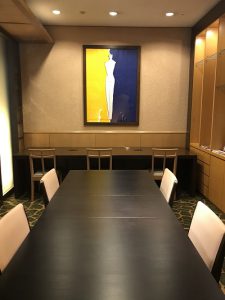四万六千日(愛知県名古屋市千種区 骨董古美術品買取致します 古美術風光舎 名古屋店)
2022.07.10
みなさま、こんにちは。スタッフNでございます。
今日は7月10日納豆の日でございますね。
Nは納豆が大好きなのですが、納豆というと毎回思い出すことがあります。
身長190cmの日本大好きアメリカ人のスティーブンが、唯一嫌いなものがありまして、それが納豆でございました。
「二ホンスバラシイ!」と何でも褒めていてくれたのに、納豆だけ「コノヨノモノデハナイ・・・」と言っていたのを思い出します。
それなのに毎日私たち家族が朝納豆を食べるので、スティーブンにとって日本の朝食は苦い思い出だったかもしれません。
そんな納豆について語りたいのですが、伝えきれませんので今日は別の話題を。
改めて、7月10日は四万六千日(しまんろくせんにち)でございます。
恥ずかしながら四万六千日を初めて知りましたので、これを機に調べてみました。
7月9日・10日、東京浅草寺で行われております観音の縁日のことで、この日に参詣(さんけい)すれば四万六千日参詣したのと同じ功徳(くどく)があるといわれます。
境内を彩るほおずきの屋台は、浅草の夏の風物詩で、この両日は四万六千日の縁日であり、縁日にともなってほおずき市が催されます。
平安時代頃より、観世音菩薩の縁日には毎月18日があてられてきましたが、室町時代末期(16世紀半ば)頃から、「功徳日」といわれる縁日が設けられるようになりました。
功徳日とは、その日に参拝すると、100日、1,000日分などの功徳が得られるという特別な日を指します。
功徳日は寺社によって異なりますが、現在、浅草寺では月に1度、年に12回の功徳日を設けております。
このうち7月10日は最大のもので、46,000日分の功徳があるとされることから、特に「四万六千日」と呼ばれるそうです。
この数の由来は諸説ありまして、米の一升が米粒46,000粒にあたり、一升と一生をかけたともいわれますが、定かではございません。
46,000日はおよそ126年に相当し、人の寿命の限界ともいえるため、「一生分の功徳が得られる縁日」と言われております。
四万六千日の縁日の参拝は江戸時代には定着し、われ先に参拝しようという気持ちから、前日9日から境内は参拝者で賑わうようになりました。
このため、9日、10日の両日が縁日とされ、現在に至ります。
四万六千日にともなうほおずき市の起源は、明和年間(1764〜72)とされております。
四万六千日の縁日は浅草寺にならって他の寺社でも行なわれるようになり、芝の愛宕神社では四万六千日の縁日にほおずきの市が立ちました。
「ほおずきの実を水で鵜呑み(丸飲み)すれば、大人は癪(なかなか治らない持病)を切り、子供は虫気(腹の中にいると考えられた虫による腹痛など)を去る」という民間信仰があり、ほおずきを求める人で賑わったそうでございます。
その愛宕神社のほおずき市の影響を受け、四万六千日の大本である浅草寺にもほおずき市が立ちました。
ちょうどお盆の季節でもあり、ほおずきを盆棚飾りに用いる方も多くいらっしゃいます。
かつては、四万六千日の縁日に赤とうもろこしを売る屋台もありました。
これは赤とうもろこしが落雷除けのお守りになる由の民間信仰により、文化年間(1804〜18)頃に境内で売られるようになったそうです。
ところが明治初年(1868)頃、不作によって赤とうもろこしが出回らないことがあったそうです。
これに困ったご信徒が浅草寺に雷除けのお守りを求めた縁から、浅草寺では竹串に挟んだ三角形の守護札を授与するようになりました。
これが今も四万六千日に授与されている雷除札でございます。
赤とうもろこし、画像検索致しましたら、結構グロテスクでございました。
とうもろこしは黄色だから可愛いのですね。
9日・10日の両日、いなせな恰好の売り子たちが声をあげてほおずきを売り、境内は朝から晩まで参拝者で埋まります。
東京かあ、遠いな・・・と肩を落としたそこのあなたに朗報でございます。
名古屋周辺では8月9日が『九万九千日』で、大須観音、犬山寂光院、笠寺観音などで大功徳日となっているそうです。
八事・興正寺西山観音堂は8月10日ですので、お立ち寄りの際は是非古美術風光舎にも遊びにいらしてくださいませ。
ではでは

Hello everyone. This is Staff N.
Today is July 10th, Natto Day.
N loves natto, but I always remember natto.
Stephen, an American who loves Japan and is 190 cm tall, had the only thing he disliked, and that was natto.
He praised me for everything, “Nihonsubarashii!”, But I remember him saying only natto, “Konoyonomonodehanai …”.
Even so, Japanese breakfast may have been a bitter memory for Stephen, as our family eats morning natto every day.
He wants to talk about such natto, but I can’t tell him so I’ll talk about another topic today.
Once again, July 10th is 46,000 days.
I was ashamed to know about 46,000 days for the first time, so I took this opportunity to investigate.
It is said that the Kannon fair held at Sensoji Temple in Tokyo on July 9th and 10th has the same merit as visiting 46,000 days if you visit this day. increase.
The Hozuki stalls that decorate the precincts are a summer tradition in Asakusa, and both days are 46,000 days of fairs, and Hozuki City is held along with the fairs.
Since the Heian period, the fair of the Kanzeon Bodhisattva has been on the 18th of every month, but from the end of the Muromachi period (mid-16th century), a fair called “Merit Day” has been set up.
A merit day is a special day when you worship on that day and get 100 or 1,000 days worth of merit.
The merit days vary depending on the temple and shrine, but at present, Sensoji Temple has 12 merit days once a month.
Of these, July 10th is the largest, and it is said that it has the merit of 46,000 days, so it is especially called “46,000 days”.
There are various theories about the origin of this number, and it is said that one square of rice is equivalent to 46,000 grains of rice, and it took a lifetime, but it is not certain.
Since 46,000 days is equivalent to about 126 years and can be said to be the limit of human life, it is said to be a “fair day where the merit of a lifetime can be obtained”.
The 46,000-day fair worship was established in the Edo period, and the precincts became crowded with worshipers from the 9th of the previous day because of the desire to worship first.
For this reason, both the 9th and 10th are designated as fairs and continue to the present day.
The origin of Hozuki City, which accompanies 46,000 days, is said to be during the Meiwa era (1764-72).
The 46,000-day fair was held at other temples and shrines following Sensoji Temple, and at the Atago Shrine in Shiba, the Hozuki Market was established on the 46,000-day fair.
Folk belief that “If you swallow (drink whole) the fruit of physalis with water, adults will get rid of tantrum (a chronic disease that does not heal easily), and children will get rid of worms (such as abdominal pain caused by insects thought to be in the stomach).” It seems that it was crowded with people seeking hozuki.
Under the influence of the Hozuki City of Atago Shrine, the Hozuki City was established at Sensoji Temple, which is the main book of 46,000 days.
It’s the season of Obon, and many people use Hozuki as a decoration for the tray.
There used to be a stall selling red corn on the 46,000th day of the fair.
It is said that red corn was sold in the precincts around the cultural year (1804-18) due to the folk belief that red corn is a talisman to prevent lightning strikes.
However, around the first year of the Meiji era (1868), it seems that red corn did not appear on the market due to poor harvest.
Since the congregation who was troubled by this asked Sensoji Temple for a talisman to protect against lightning, Sensoji Temple began to award a triangular amulet sandwiched between bamboo skewers.
This is the lightning bill that is still awarded on the 46,000th day.
When I searched for red corn and images, it was quite grotesque.
The corn is yellow, so it’s cute.
On the 9th and 10th, the innocent-looking sellers scream and sell the physalis, and the precincts are filled with worshipers from morning till night.
Good news for you who dropped your shoulders, saying that it’s far from Tokyo.
Around Nagoya, August 9th is “99,000 days”, and it is said that Osu Kannon, Inuyama Jakoin, Kasadera Kannon, etc. have become great merit days.
Yagato Kosho-ji Nishiyama Kannon-do is on August 10th, so please come visit us at the Ancient Art Fukosha when you visit.
See you soon
*********************
このところ、整理やお片付けなどをされている方のご相談などが多くございます。お暑い日が続きますのでくれぐれもご無理のないように、なさってくださいませ。風光舎では、古美術品や骨董品の他にも絵画や宝石、趣味のお品など様々なジャンルのものを買受しております。
お片付けをされていて、こういうものでもいいのかしらと迷われているものでも、どうぞお気軽にご相談下さいませ。
また風光舎は、出張買取も強化しております。ご近所はもちろん、愛知県内、岐阜県、三重県その他の県へも出張いたします。
まずは、お電話お待ちしております。
愛知県名古屋市千種区・骨董 買取
『古美術 風光舎 名古屋店』
TEL052(734)8444
10:00-17:00 OPEN

